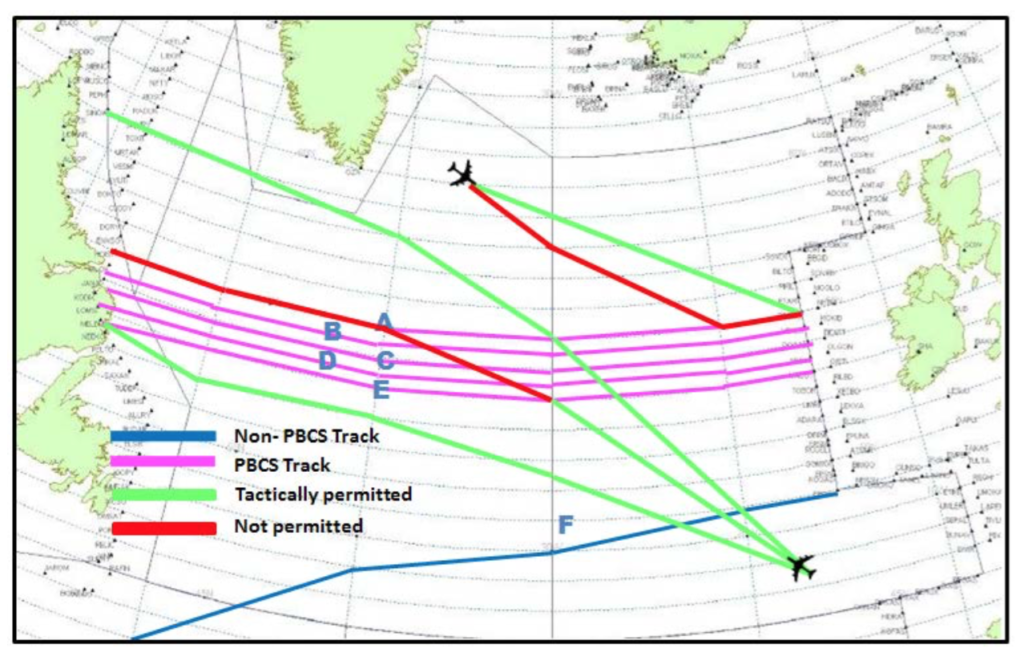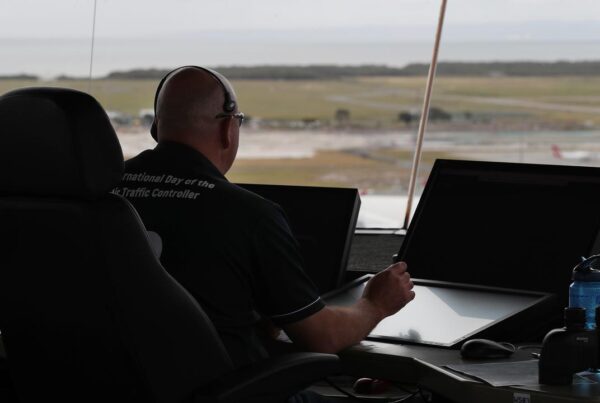Update March 16th, 2018: PBCS is turning into a PITA. After OPSGROUP input, we have an update on the latest status including rumours of delays, A056 LOA’s, and Aircraft that have failed to comply with PBCS.
For the latest changes and updates on the North Atlantic, including our most recent Guides and Charts, use our NAT reference page at flightservicebureau.org/NAT.
ICAO is introducing another acronym in the North Atlantic Region. This time, it’s PBCS (Performance Based Communication and Surveillance), and from March 29th 2018 you will need to be compliant if you want to fly on the half-tracks between FL350-390.
Initially, there will only be a maximum of three daily tracks where you will need to be PBCS-compliant between FL350-390. These will likely be the same tracks as we currently see being assigned as ‘half-tracks’ each day.
This requirement will eventually be extended to all the NAT tracks between FL350-390, but we understand that will only happen when the filing of PBCS designators on flight plans reaches the 90% mark, or 28th March 2019 – whichever comes first. Either way, the ‘transition period’ for this PBCS implementation is set to last six months, so the roll-out of the requirement to all the tracks won’t happen until Oct 2018 at the earliest!
But from March 29th 2018, Shanwick and Gander will basically just continue the concept used in the RLatSM trial – whereby daily tracks spaced at less than 60nm from an adjacent track will be specified as a ‘PBCS Track’ and will be notified in the Track Message Remark-3.
So what is PBCS?
PBCS is the thing that will replace two trials in the NAT which are both coming to an end on March 29th:
- RLAT – Reduced Lateral Separation Minimum: where a reduced lateral separation of 25 nm has been implemented on the tracks between FL350-390 (so now there are extra “half tracks” each day, spaced by one-half degree of latitude)
- RLong – Reduced Longitudinal Separation Minimum: in the Shanwick Oceanic Control Area (OCA), longitudinal separation has been reduced to 5 minutes between aircraft following the same track.
When these trials end, PBCS standards will be introduced to continue to allow the application of both reduced lateral and longitudinal separation for aircraft that meet the Required Communication Performance (RCP) and Required Surveillance Performance (RSP) specifications.
How do I comply with PBCS standards?
To operate on the PBCS tracks between FL350-390, you will need to be RNP4 compliant, with CPDLC capable of RCP240, and ADS-C capable of RSP180.
But watch out! Some aircraft do have ADS-C and CPDLC but have never demonstrated RCP or RSP, and have no statement of compliance (e.g. most Honeywell Primus aircraft and several early Boeing aircraft). These aircraft may struggle to get approval to operate in PBCS airspace. Which brings us neatly on to…
Do I need PBCS approval from my state of registry?
PBCS approval will differ depending on which country operators are from.
For UK operators, check the requirements here.
US operators will need to update their LOA for Data Link Communications (A056). The FAA have published a new guide, which tells operators exactly what they need to do to get this authorisation, namely:
- Submit an AFM Statement of Compliance for PBCS, showing exactly what data link communication systems you aircraft has, along with the selected performance
- Since July 2016, various oceanic FIRs have been collecting data on whether certain aircraft meet RSP and RCP criteria. You need to make sure your aircraft isn’t already listed as having failed to meet these criteria, by checking here: https://www.faa.gov/air_traffic/separation_standards/pbcs_monitoring/
What new codes do I need to put down on my flight plan?
- FANS 1/A CPDLC equipped aircraft planning to operate in the NAT HLA shall insert the appropriate designator (J2, J3, J4, J5 and/or J7) in Item 10a of the flight plan.
- FANS 1/A CPDLC RCP 240 compliant aircraft intending to operate in the NAT HLA shall insert the designator P2 in Item 10a of the flight plan.
- FANS 1/A ADS-C compliant aircraft planning to operate in the NAT HLA shall insert the designator D1 in Item 10b of the flight plan.
- FANS 1/A ADS-C RSP 180 compliant aircraft planning to operate in the NAT HLA shall insert SUR/RSP180 in Item 18 of the flight plan.
- RNP 4 compliant aircraft planning to operate in the NAT HLA shall insert PBN/L1 in Item 18 of the flight plan.
If I’m not eligible for PBCS, where can I go?
ATC may allow you to do either of the following, depending on how stressed/busy they are (i.e. decided on a ‘tactical basis’):
- You can infringe on the daily PBCS tracks between FL350 – FL390 at only one point (including Oceanic Entry/Exit Point) i.e. cross but not join an NAT PBCS track
- You can climb or descend through levels FL350 – FL390 on a PBCS track provided the climb or descent is continuous.
In their NAT OPS Bulletin 2018_001, ICAO have published a handy little picture to demonstrate this:

Further information:
- For a great FAQ on all things PBCS, check out the latest FAA document here.
- For more info on the PBCS implementation, check out the full UK AIC here.
- To figure out where you are welcome on the NAT, depending on what equipment and training you have, check out our quick reference guide here.
- Special thanks go to Mitch Launius at 30westip.com for help with this post. For assistance with international procedures training for business aviation crews worldwide, and to watch an excellent webinar about all things PBCS-related, check out the 30westip.
More on the topic:
- More: Oceanic Clearance Removal mess – delayed to December
- More: NAT FAQ: No HLA approval – Where can we go?
- More: NAT FAQ: No RVSM – Where can we go?
- More: NAT FAQ: No Datalink – Where can we go?
- More: NAT Clearance changes – a game!
More reading:
- Latest: Outsmarting GPS Tricks: Easy Solution for Spoofing
- Latest: TIBA in Australia: What’s Going On?
- Latest: That MMEL Thing: Here’s an Update
- Safe Airspace: Risk Database
- Weekly Ops Bulletin: Subscribe
- Membership plans: Why join OPSGROUP?











 Get the famous weekly
Get the famous weekly 






New FAA A056 document published this month. Several sections updated. New Appendix with PBCS Charter information. Link below
https://www.faa.gov/about/office_org/headquarters_offices/avs/offices/afx/afs/afs400/afs470/datacomm/media/A056_Compliance_Guide.pdf
Thanks Dan, we’ve incorporated that doc into the article now! 🙂
The code in SUR should be RSP180 not 180.
Thanks Tony! Updated …
I asked the ICAO office for SE Asia, and the mandates in SE Asia arent really mandates. They will make separation determinations based on your filed codes, but there will be no airspace in SE Asia (at least at the start) that will be RCP RSP required.
Thanks Doug – I think we’re gonna do a completely separate article about PBCS worldwide. There’s a good little map in that FAQ doc the FAA produced, that shows all the FIRs around the world where PBCS will be introduced, but I’m sure there are will be more and more countries implementing this soon (Sri Lanka have already said they will, for example).